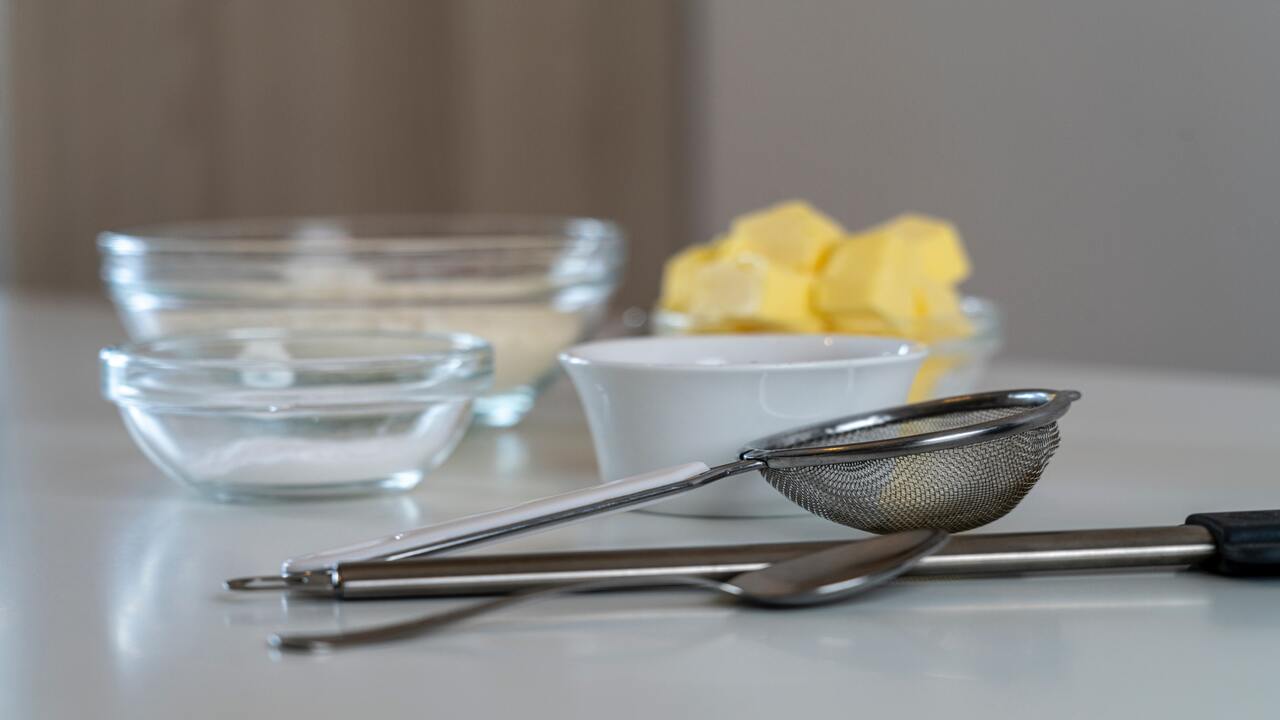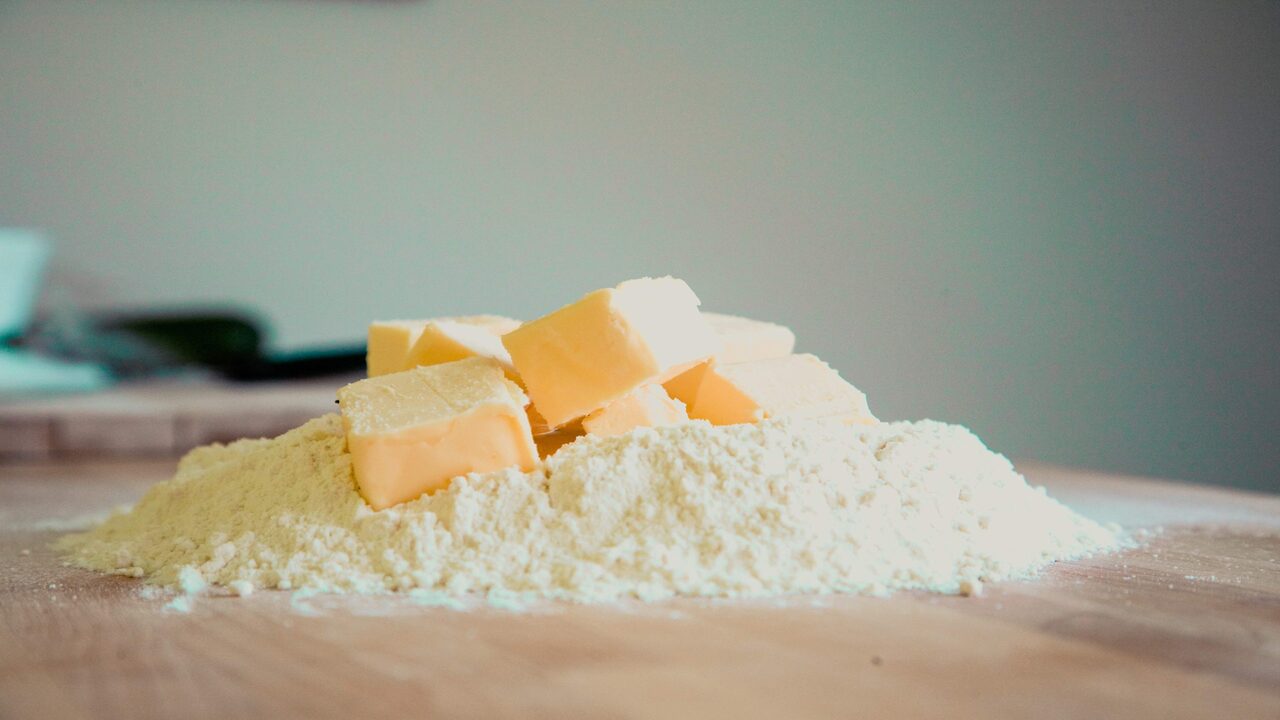What Is Roux? It is a cooked mixture of flour and butter, is part of French cuisine’s foundations. This combination acts as a thickener agent, giving a subtle nutty flavor and color to various sauces, broths, and soups.
It is mainly present in four of the five mother sauces: Béchamel, Espagnole, Velouté, and Tomato Sauce.
Learn now about the 4 types of roux – blanc, blond, brown, and dark roux, and how to prepare them.
It is advisable to use clarified butter in the preparation of roux, other kinds of fat should only be used for serious reasons of economy.
-Auguste Escoffier – French chef, restaurateur and writer
You can also watch this and other exclusive GA Originals on YouTube.
Jump To Section
- What Is a Roux?
- The Origin
- How Does It Works?
- Essential Tips To Consider When Making Roux
- How to Make A Classical Roux In 5 Easy Steps
What Is A Roux?
It is a cooked mixture of equal weights of flour and fat that is used as a thickening agent in sauces, broths, stews, and soups.


It is also responsible for giving dishes a toasty flavor and a silky, smooth texture.
Traditionally, 120g of roux (60g of flour and 60g of fat), in which butter is the most used, is enough to thicken one liter of liquid.
There are four types of roux: blanc, blond, brown, and dark roux. The latter is widely used in Cajun and Creole cuisines that have adopted European, African, and Caribbean influences.
Each type of roux plays a vital role in the sauces, broths, or soups that will be incorporated.
For example, Espagnole requires a brown roux to add color and toasty flavor, as the sauce is also dark in color, while Béchamel needs a white roux to thicken it without changing its color.
The Origin
It must have passed unnoticed into French cookery when brought by the cooks of Anne of Austria, a Spanish princess, Anne of Austria (1601-1666), Queen consort of King Louis XIII of France, and regent during the early years of the reign of her son King Louis XIV.

Previously, sauces were thickened with bread crumbs. In the middle of the 17th century, It was introduced by the famous French chef and writer François La Varenne when he started using it in his recipes.
The smooth, silky roux quickly replaced bread crumbs as a thickening agent.
A century later, French settlers moved to America, bringing roux, which became part of Cajun and Creole cuisine in New Orleans, USA.
Nowadays, the local recipes carry European, African, and Caribbean influences, with Cajun and Creole being the reflection, creativity, and adaptation of the different people who live in that region.
A darker thickener agent emerged from this influence than the dark roux commonly used in French cuisine.
How Does It Works?
It thickens many dishes, giving a unique flavor; however, how does it work? However, for that to happen, some chemical reactions must be understood.
Heat
High heat will cause the starch granules to harden and prevent them from combining with the liquid when added to form a sauce.
On the other hand, gradually increasing the temperature, the outer coating of the starch granules swell and breaks, transforming into dextrin – a substance responsible for the thickening process.
That’s why it’s important always to prepare the roux on low heat and never on high.
Types of roux
Traditionally, French cuisine has three types of roux: blanc, blonde, and brown. The fourth one, dark roux, was introduced into culinary after Creole and Cajun cuisines emerged in New Orleans, USA.
- Blanc: Used to thicken white sauces like béchamel. It cooks quickly to combine the elements and eliminate the flour flavor.
- Blond: It thickens sauces with a more yellowish and golden color, such as velouté sauce.
- Brown: Enriches the flavor and adds more dark color to dark sauces, for example, demi-glace, Espagnole, and others of the same shade.
- Dark Roux: Present in Cajun and Creole recipes that require a more highlighted flavor and color, like dark brown.
Timing
The time required to cook the different types of roux varies from 3 to 20 minutes, depending on the need and the characteristics of the liquids into which the roux will be incorporated.
See now the estimated cooking time of each of them:
- Blanc: 3 minutes
- Blonde: 5 minutes
- Brown: 10-15 minutes
- Dark Roux: 20 minutes
Thickening power
The blanc roux has greater thickening power than the others. Its short cooking time causes the starch grains to swell and break, turning into dextrin, a substance responsible for the thickening process, while brown or dark roux, due to the longer cooking time, loose this ability during the preparation.
Flour
Flour is more stable, as the starches present do not break easily compared to other thickeners. Cake flour has more starch than bread flour, so it thickens more. All-purpose flour is among the two, being the most used in professional kitchens for the preparation of roux.
Fat
Many types of fats can prepare a roux, such as vegetable oil, whole butter, or others; however, it will directly influence the dish’s taste. Traditionally, butter is the most used.
Therefore, butter is the most used, with clarified butter being one of the many preferences for chefs. Clarifying butter means removing water and solids present in milk, which would harm cooking preparations.
Ratio: Flour Vs. Fat
The approximate quantities of roux needed to thicken 1 Liter of liquid to thin, medium, and thick consistencies are:
| Sauce | Flour | Fat | Liquid |
| Thin | 48 g | 48 g | 1L |
| Medium | 60 g | 60 g | 1L |
| Thick | 95 g | 95 g | 1L |
Note: Many types of flour, such as rice flour, arrowroot, cornstarch, tapioca flour, and potato starch, would give the same result as all-purpose flour but take into account the other substances contained in these flours.
Essential Tips To Consider When Making Roux
One of the most frequently asked questions is about how to make a roux properly. It is a simple and quick recipe. Just cook equal parts flour and butter. However, there are some tips that we should consider.
Avoiding lumps
The way that it is mixed with the liquid can create lumps. In general, a cold roux is added to the hot liquid, while a hot roux is added to the cold liquid.
Ideally, it should be tempered with a bit of liquid. Thus, we will give time for the ingredients to be incorporated as a whole, turning into a paste. Then add the rest of the roux to sauces or broths, proceeding as per the recipe.
On the contrary, mixing hot roux with hot sauce or cold sauce with cold liquid will create lumps.
Sift the flour
This practice prevents unwanted residues from being incorporated into preparation. It is a standard quality practice in professional kitchens to sift all the flour before being used.
Heat intensity
Cook slowly over medium to low heat in a double-bottom saucepan instead of too quickly over high heat, which can cause the starch granules to harden and not thicken your sauce.
Mixing constantly
After the butter has melted, add the flour and constantly stir over the heat to obtain a homogeneous mixture and uniform color.
Starch property
Starch, usually flour, gelatinizes between 60°C to 90°C / 140°F to 194°F. This is the time when it starts to thicken a liquid.
A common mistake is that some cooks don’t have patience and think the amount of roux will not thicken the sauce. So, they start adding more roux or simply flour. As a result, the preparation may be too thick or taste like raw flour.
Don’t make the same mistake, but follow the recommended proportions of flour, fat, and liquid, and wait for the temperature to work together with the roux.
Tasting notes
A good tip to know when it’s ready, it smells like hazelnuts, popcorn, or baked flour.
Storing
Preparing the roux ahead is practical, and keeping it in the refrigerator for several weeks in an airtight container.
How to Make A Classical Roux In 5 Easy Steps
It is simple and easy to make. However, the preparation technique will reflect on the final result of your sauce, broth, soup, or stew. Learn now how to prepare it.
Now, get to work! 😋

Blanc Roux
Equipment
- Saucepan
- Whisk
- Sieve
- Wooden spoon
- Small mixing bowl
Ingredients
- 60 g All purpose flour
- 60 g Unsalted butter optional – 60 g of clarified butter
Instructions
- Sift the flour in the mixing bowl.
- Melt the butter in a small saucepan over medium heat.
- When the butter starts to foam, add the sifted flour.
- Mix well and cook slowly for about 3 minutes.
- When the roux starts to have hazelnut aromas, it is ready. Transfer to another container and set aside.
Notes
Did you make this recipe?
Please let me know how it turned out for you! Leave a comment below and share our content.
Help our community grow by following our social media on Spotify, Instagram, Facebook, Youtube, and Tiktok. And stay up to date with the news from the world of Gastronomy.
Don’t forget to tag @gastrovinoacademy on Instagram and hashtag it #gastrovinoacademy.
Cheers🍷


